Humans face extinction due to a mix of climate change, habitat destruction, and unsustainable practices. As temperatures rise, extreme conditions threaten our survival. Overfishing and pollution compromise marine ecosystems, while deforestation reduces wildlife's carrying capacity. History shows that mass extinction events often result from rapid environmental shifts, and current rates of species loss are alarming. You might be exposed to rising CO₂ levels and ecological collapse in the coming decades. If you want to understand the specifics of these risks and what you can do about them, there's more to explore on this critical issue.
Essential Insights
- Current extinction risks include climate change, with CO₂ levels projected to reach 800 ppm by 2100, threatening ecosystems and human survival.
- Human activities, such as habitat destruction and overfishing, are driving extinction rates 100-1,000 times higher than natural background levels.
- Potential short-term threats involve global thermonuclear war and ecological collapse, while mid-term risks include supervolcanic eruptions and asteroid impacts.
- Historical mass extinction events, like the Permian-Triassic, show the vulnerability of species, suggesting humans may face similar fates if current trends continue.
- Collaboration and collective action are essential to mitigate risks, emphasizing the need for urgent climate justice and sustainable development initiatives.
Future Extinction Causes

As we look ahead, it's crucial to recognize how various factors could lead to human extinction. One major concern is anthropogenic extinction driven by ecological collapse. Habitat fragmentation and the introduction of non-native species diminish biodiversity, while deforestation for agriculture reduces the Earth's carrying capacity for wildlife. Overfishing and ocean acidification threaten marine ecosystems, compounding these risks. Additionally, the current extinction rates are estimated to be 100 to 1,000 times higher than natural background rates, indicating a severe crisis that could have dire consequences for humanity.
Technological advancements bring their own threats. The rise of artificial intelligence could pose a greater risk to humanity than even nuclear threats or pandemics. If mismanaged, AI could lead to scenarios far worse than anticipated.
Similarly, genetic engineering and technological augmentation might create new species or subspecies that could displace naturally evolved humans, altering the course of our evolution in unpredictable ways.
Biological warfare remains a chilling possibility, with advanced weaponry capable of catastrophic consequences. The risk of resource conflicts grows as overpopulation and consumption strain our planet's limits, potentially igniting large-scale conflicts that could spiral into nuclear threats.
These global tensions could lead to ecological collapse, further endangering human survival.
In essence, you must understand that the interplay of environmental degradation and technological risks creates a precarious situation. As we move forward, the consequences of our actions will determine whether humanity can avert these looming threats or faces an uncertain future marked by extinction.
The Role of Climate Change

Climate change plays a significant role in shaping the future of humanity, intertwining with the various extinction causes already discussed. While there's no direct evidence suggesting climate change will cause human extinction, the potential for a runaway greenhouse effect looms ominously. This scenario involves unstoppable climate feedback loops that could lead to the evaporation of oceans, ultimately making the planet uninhabitable.
Historically, climate change has influenced numerous mass extinction events, contributing to the downfall of past civilizations and the extinction of species like the Neanderthals. Their populations fragmented due to climatic fluctuations, which also impacted their food sources. These precedents serve as a reminder that while human resilience is strong, we can't ignore the risks posed by severe climate changes. Extreme weather events could become more frequent without emission cuts, heightening the threat to food security and human survival.
Essential tipping points are on the horizon. Crossing the 450 ppm carbon threshold may threaten half of humanity by mid-century, pushing us toward economic, social, and political collapse before total extinction. The final phase, at 750 ppm, could result in catastrophic outcomes for both humans and the broader ecosystem.
It's important to recognize that the potential for climate change to lead to human extinction is dangerously underexplored. Researchers urge for a deeper understanding of worst-case scenarios, especially as climate breakdown may amplify existing threats like inequality and misinformation.
Projected Climatic Conditions

Imagine a world where the climate has drastically changed, shaped by the formation of a supercontinent known as Pangea Ultima. In about 250 million years, you'll witness a largely inhospitable environment marked by extreme temperatures and humidity. This new landmass, primarily located in the hot, humid tropics, will lead to significant habitat fragmentation, reducing habitable land by 8% to 16%.
With increased volcanic eruptions releasing vast amounts of CO2, levels could skyrocket from 400 ppm to over 600 ppm—even higher if fossil fuel consumption continues. The sun's brightness will also increase, emitting about 2.5% more radiation, which, combined with elevated CO2 levels, will intensify global warming. Additionally, the projected climate conditions will further challenge the survival of mammals adapted to cooler environments.
Imagine temperatures soaring between 40 to 70 degrees Celsius across many areas, creating daily extremes that make survival nearly impossible. As these climate feedbacks unfold, you'll see a hostile landscape devoid of food and water, pushing mammals—including humans—beyond their limits.
Struggling to shed heat through sweat, survival will become a daily challenge against terminal heat stress. The climate models simulate these dire conditions, factoring in tectonic movements and ocean chemistry, predicting a world where climate extremes are the norm rather than the exception.
In this altered reality, the very fabric of life as you know it will be irreversibly changed, underscoring the fragility of existence in the face of such dramatic climatic conditions.
Impact on Mammalian Species
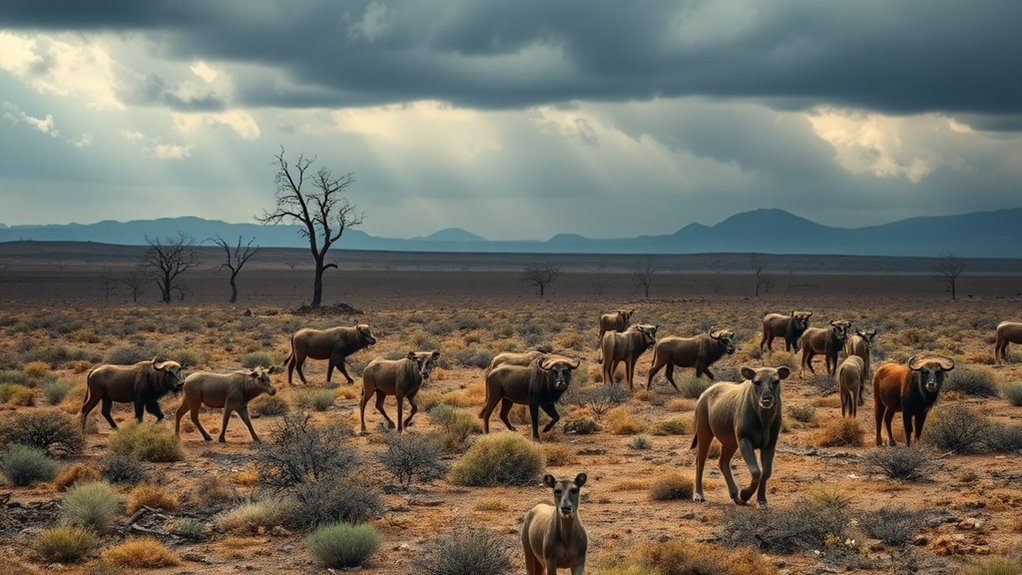
Human activities have consistently pushed mammalian species toward extinction, with devastating consequences for ecosystems worldwide. Over the last 50,000 years, human hunting has played a decisive role in driving at least 161 species of mammals to extinction, particularly large herbivores. This loss hasn't only diminished biodiversity but has also disrupted ecological balance, affecting vegetation structure, seed dispersal, and nutrient cycling.
You might be surprised to learn that these extinctions occurred across all continents except Antarctica, indicating that habitat loss wasn't the sole culprit.
Today, extinction rates for vertebrate species are alarmingly high, with humans accelerating these rates hundreds of times faster than natural processes. As you consider the implications, remember that nearly 59% of living megafauna are currently threatened, and many are experiencing declines in their populations. This rapid decline poses a significant risk to mammalian resilience, as the loss of these species can destabilize entire ecosystems.
Looking ahead, projections suggest that by 2070, around 1,700 species—including mammals—could face increased extinction risks due to ongoing human land-use changes. You may find it concerning that these changes will likely result in the loss of 30-50% of their current habitat ranges, further jeopardizing their survival. Additionally, habitat loss will be concentrated in regions with high biodiversity, amplifying the threat to many species.
The extinction of large mammals has profound ecological consequences, emphasizing the urgent need for conservation efforts to restore ecological balance and protect the diverse tapestry of life on Earth.
Human Adaptability and Limitations

As mammalian species face increasing extinction risks, it's imperative to recognize that humans possess both remarkable adaptability and inherent limitations. You might think of adaptation strategies as our primary means of overcoming challenges, yet these strategies often encounter significant barriers. Economic impacts, such as insufficient financial resources, can hinder your ability to implement effective resilience building. Social constraints, including cultural perspectives and norms, may further restrict adaptation efforts, leading to soft limits where options aren't yet available but could be in the future.
Governance challenges also play a significant role. Inadequate institutional frameworks and lack of political will can stymie coordinated responses to climate change. Without effective governance, adaptation becomes fragmented, limiting your capacity to enact meaningful change. Additionally, financial resources identified as a significant barrier to effective adaptation can exacerbate these governance challenges.
Technological innovations offer hope, but they often face infrastructural needs that are difficult to meet, especially in vulnerable regions where hard limits might emerge. Ecosystem management is equally essential. As biodiversity conservation efforts struggle against environmental degradation, the effectiveness of ecosystem-based adaptation strategies diminishes. Climate change exacerbates these issues, making water-related adaptations less effective as temperatures rise.
Recognizing these limitations is significant for you to understand the complexity of human adaptability. While soft limits can be overcome with concerted efforts, hard limits may leave you with no viable options, highlighting the urgent need for thorough strategies that address both human and ecological resilience.
Timeline for Potential Extinction
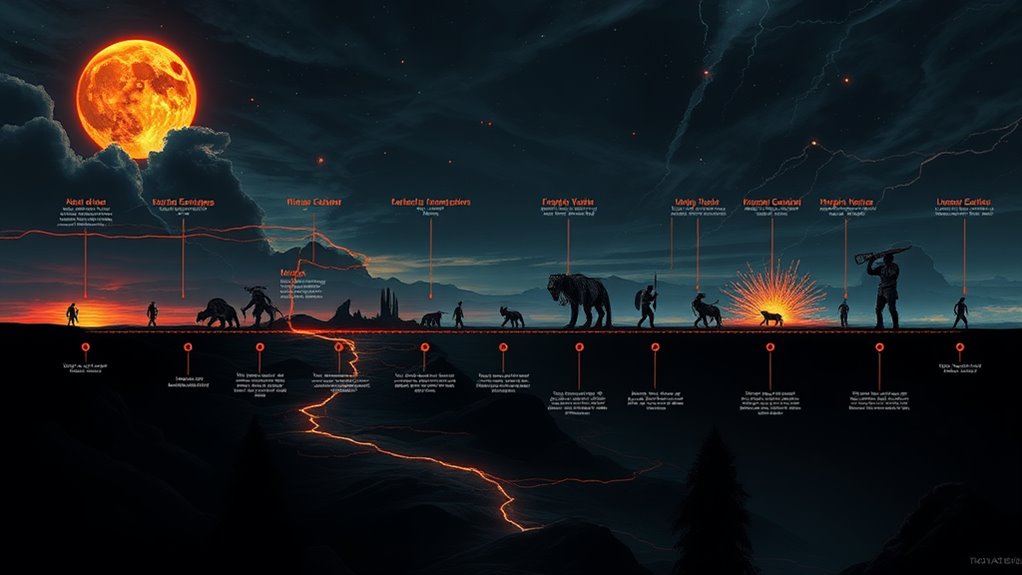
Throughout history, multiple factors threaten the survival of our species, with various timelines for potential extinction emerging based on the nature and severity of these risks. You need to reflect on both short-term and long-term extinction scenarios to grasp the full picture.
| Timeframe | Extinction Risks |
|---|---|
| Short-Term | Global thermonuclear war, biological weapons, ecological collapse, runaway AI, climate change |
| Mid-Term | Supervolcanic eruptions, asteroid impacts, nearby supernovae, extreme solar flares, genetic engineering |
| Long-Term | Supercontinent formation, increased solar brightness, tectonic processes, changes in Earth's orbit |
| Theoretical Estimates | 95% chance of extinction in 7.8 million years, 30% in 500 years, 1% by 2100 |
| Survival Strategies | Adaptation, technological advancement, global cooperation, ecological restoration |
In the short term, threats like global thermonuclear war or runaway artificial intelligence could lead to immediate extinction. As you look further into the future, risks like supervolcanic eruptions and asteroid impacts emerge, while millions of years down the line, natural processes could reshape Earth's environment. The formation of a supercontinent is expected to significantly exacerbate extreme climate conditions, further endangering mammalian survival.
Evaluating these risks, it is crucial to develop survival strategies. By fostering global cooperation and advancing technology, you can help mitigate the potential for extinction. Awareness of these timelines allows you to prepare for the challenges ahead, ensuring that humanity remains resilient in the face of uncertainty.
CO₂ Levels and Their Impacts
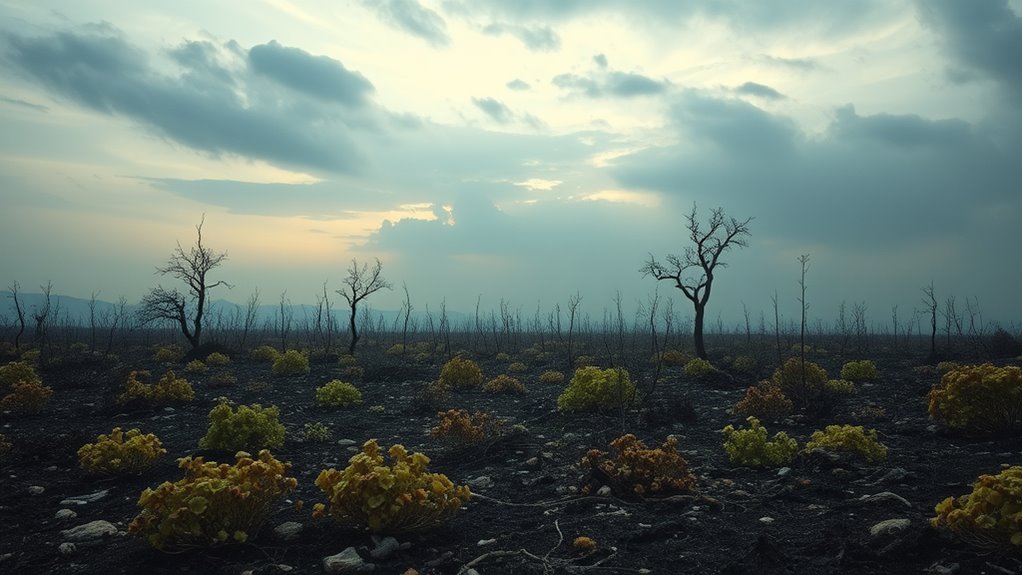
The escalating levels of CO₂ in the atmosphere pose a significant threat not just to marine life, but to global ecosystems and human survival. With CO₂ concentrations surpassing 421 parts per million (ppmv), we're witnessing the highest levels in human history. This rapid rise, driven largely by CO₂ emissions from fossil fuels and land use changes, is occurring 100 times faster than natural increases seen after the last ice age. If we don't act, projections indicate that CO₂ levels could reach 800 ppmv by 2100.
This increase contributes to the greenhouse effect, trapping heat and elevating Earth's average temperature. Ocean acidification emerges as one of the most immediate dangers, reducing calcium carbonate availability for marine organisms. This threatens marine ecosystems, particularly corals and invertebrates, and is linked to historical biodiversity loss and mass extinctions. The loss of biodiversity affects the entire food chain, exacerbating extinction rates.
Moreover, the interplay of rising CO₂ levels and climate feedback mechanisms disrupts ecological resilience, making it harder for species to adapt. Anoxia, or loss of oxygen in waters, arises from high CO₂ levels, further endangering marine life. At least 1 million species are now at risk due to these changes.
If we continue to ignore our carbon footprint, the potential for civilization collapse looms larger. To safeguard our future, we must urgently reduce greenhouse gas emissions and implement sustainable practices to mitigate these impacts on our planet.
Geological Processes at Play
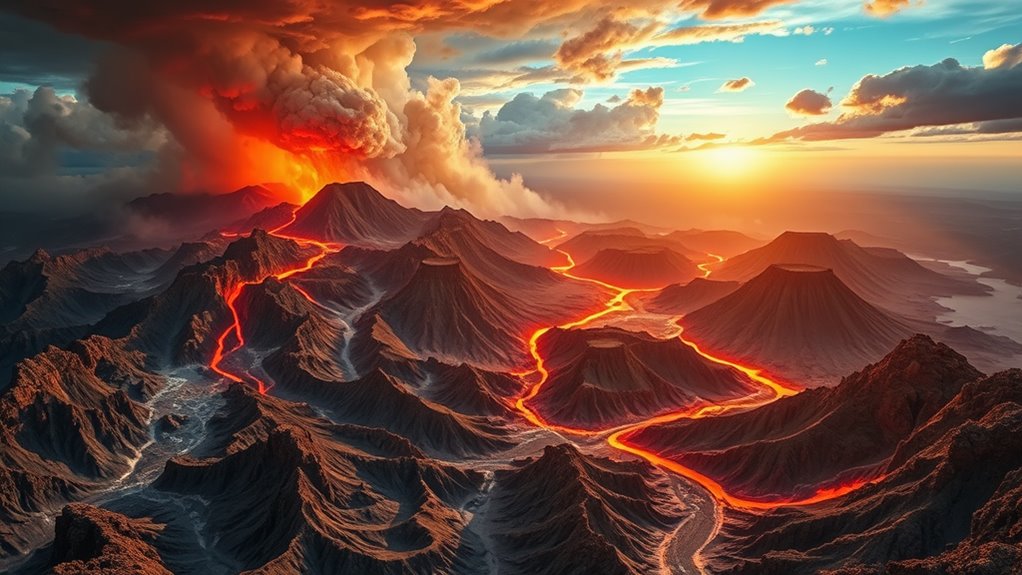
While geological processes have always shaped our planet, the current climate crisis amplifies their effects in unprecedented ways. You might not realize it, but the interplay between human activities and geological dynamics is creating a feedback loop that threatens ecological resilience. For example, extreme weather events—like intense storms and heatwaves—are destabilizing landscapes and exacerbating geological feedbacks.
Here's a summary of some key geological processes at play:
| Geological Process | Impact on Climate and Ecosystems |
|---|---|
| Albedo Change | Alters Earth's surface reflectivity, affecting temperature regulation. |
| Release of Sequestered Gases | Melting permafrost and wetlands release CO₂ and methane, further warming the planet. |
| Glacial Melting | Contributes to sea level rise, endangering coastal populations. |
| Destabilization of Slopes | Glacial recession leads to landslides, impacting habitat and biodiversity. |
| Habitat Loss | Agriculture and urbanization disrupt ecological balance, reducing resilience. |
These geological feedbacks not only threaten the stability of ecosystems but also jeopardize human survival. As glaciers melt and sea levels rise, coastal cities face inundation, while the salination of aquifers jeopardizes freshwater resources. The ongoing loss of biodiversity indicates a looming ecological collapse, where human activity continues to undermine the planet's geological stability. Understanding these processes is essential for recognizing the potential pathways to extinction that lie ahead.
Historical Mass Extinction Comparisons

Examining historical mass extinctions reveals not just the fragility of life on Earth, but also the patterns that emerge from catastrophic events. By looking at extinction event comparisons, you can see how different factors played a role in wiping out vast numbers of species.
For instance, the Permian-Triassic extinction, about 252 million years ago, stands out with a staggering 96% species extinction rate, primarily due to volcanic activity and climate change. This event set a precedent for the mass extinction patterns that followed.
Fast forward to the Cretaceous-Paleogene extinction, which occurred 66 million years ago. This event, triggered by a giant asteroid impact, led to the extinction of around 67% of species, including the non-avian dinosaurs. The stark contrast between these two events highlights how different causes—volcanism versus extraterrestrial impacts—can drastically alter the course of life on Earth.
The End-Ordovician and End-Devonian extinctions also offer critical insights. Both involved significant climate shifts, with the End-Ordovician extinction wiping out 86% of species due to ice sheet advancements and global warming.
The mass extinction patterns throughout history suggest that while the causes vary, the consequences remain devastating. In each of these cases, you can see that massive environmental changes—be it through climate, geological shifts, or external impacts—have repeatedly pushed life to the brink, shaping the biodiversity we see today.
Understanding these patterns could provide important lessons as we face our own potential extinction event.
Human Activities Driving Extinction

Human activities are rapidly driving extinction rates to alarming levels, threatening the very fabric of biodiversity on our planet. Habitat destruction, primarily through agricultural expansion, has led to the loss of around 420 million hectares of forest since 1990, causing significant biodiversity loss. The global food system is a major contributor to this crisis, putting over 85% of the 28,000 species at risk of extinction.
Resource exploitation, including overfishing, poses severe overfishing impacts on marine ecosystems, leaving one-third of fisheries overfished. Unsustainable practices in harvesting wild species further endanger countless plants and animals.
Pollution effects, from nitrogen deposition to marine plastic pollution, exacerbate these issues, with significant threats to terrestrial and marine life. Invasive species, introduced at alarming rates, have driven 60% of extinctions, costing the global economy over $423 billion annually.
The interplay of these factors disrupts ecological balance, leading to a cascading effect on the environment. Climate change intensifies these challenges, raising temperatures and spreading diseases that threaten vulnerable ecosystems.
Conservation efforts can help mitigate these impacts, but they require a commitment to sustainable practices that prioritize the health of our planet. Restoring just 15% of ecosystems in priority areas can cut extinctions by 60%.
It's imperative that you recognize the urgency of these issues and advocate for meaningful change to protect our shared biodiversity before it's too late.
Urgency for Global Action
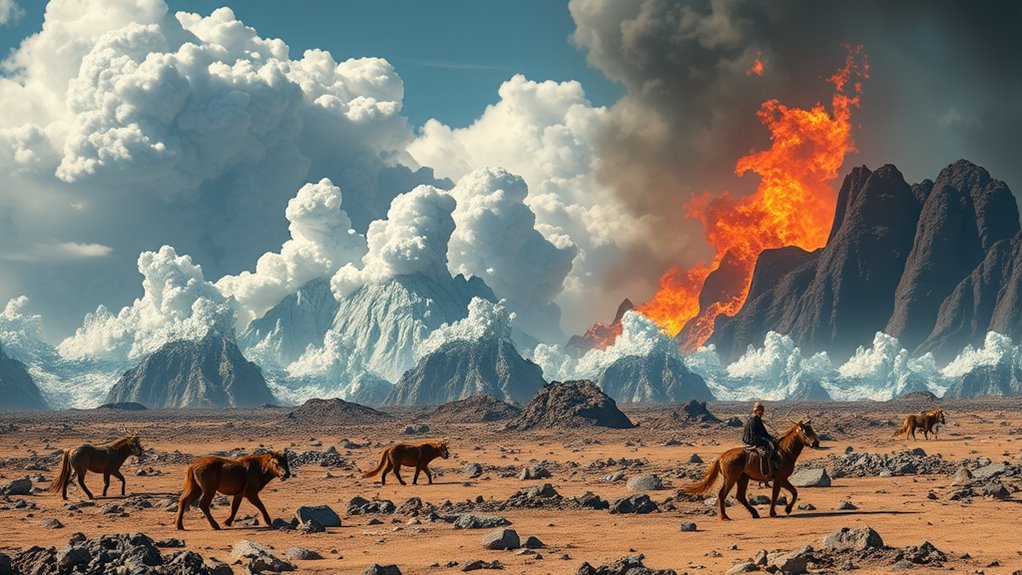
There's no denying that the time for global action is now. Climate change isn't just an environmental issue; it threatens our cultural heritage and rights. If we don't act swiftly, we risk losing invaluable cultural sites, practices, and ways of life. The United Nations has already warned us about these dangers, emphasizing the urgent need for climate justice.
You might be wondering what you can do to help address this crisis. Here are a few key points to reflect on:
- Support local cultures: Engage with and promote initiatives that protect cultural heritage threatened by climate change.
- Advocate for climate justice: Stand up for policies that guarantee vulnerable communities receive support and resources to adapt and thrive.
- Stay informed: Understand the interconnectedness of global crises and how they impact cultural rights.
- Engage in collective action: Join local and global movements pushing for immediate climate action.
The next eight years are vital for delivering on the Sustainable Development Goals. We need coordinated efforts, with strong political will and financial commitments, to shift to a sustainable economy.
Every decision you make can contribute to this change. By demanding that leaders prioritize the protection of cultural rights and act decisively against climate change, you help forge a path toward a more just and sustainable future.
Let's not wait until it's too late—acting now is essential for both our planet and the diverse cultures that enrich our world.
Strategies for Mitigating Risks
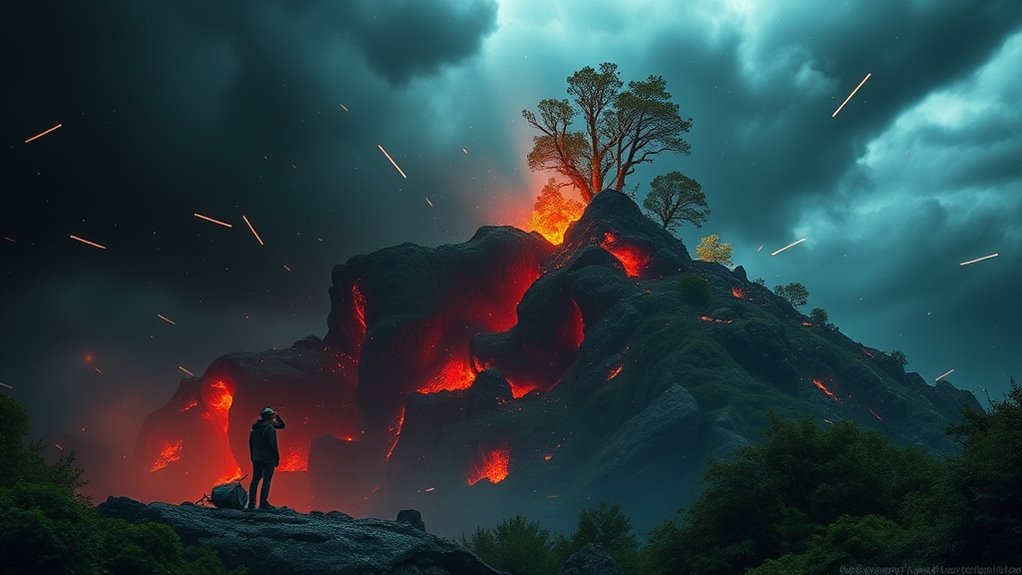
Mitigating risks associated with climate change, nuclear threats, and other global dangers requires proactive strategies that everyone can engage with. You can start by improving energy efficiency in your daily life and converting to renewable energy sources.
Embracing sustainable mobility, like biking more and using public transport, reduces carbon emissions and contributes to a healthier planet. Supporting ecological industries and responsible consumption practices not only helps the environment but also fosters sustainable agriculture.
On a larger scale, promoting nuclear disarmament is vital. Advocating for the reduction of nuclear weapons and enhancing global cooperation through treaties can greatly decrease the risk of nuclear conflict.
It's also essential to develop strategies for addressing the aftermath of potential nuclear detonation.
When it comes to asteroid threats, participating in awareness campaigns about asteroid mitigation can be beneficial. Encourage investments in technologies for asteroid detection and deflection.
Supporting space colonization initiatives could lessen our reliance on Earth.
We also face risks from biological warfare and emerging technological threats. You can advocate for stricter regulations on biological weapons and engage in conversations about the potential dangers of technologies like advanced AI.
Protecting Biodiversity and Ecosystems

Biodiversity and ecosystems are the foundation of a healthy planet, directly impacting our survival and well-being. Protecting these living systems is essential, especially in biodiversity hotspots where unique species thrive.
By conserving ecosystems, we guarantee vital ecosystem services continue to benefit us, like clean air, water filtration, and pollination of crops.
You can contribute to this effort in several ways:
- Support Protected Areas: Advocate for and visit national parks, wildlife sanctuaries, and biosphere reserves. These places maintain natural ecosystems and allow organisms to adapt to their environments.
- Engage in Habitat Restoration: Participate in local initiatives that restore forests, wetlands, and waterways. Restoring these habitats not only helps biodiversity but also mitigates climate change.
- Practice Sustainable Habits: Choose to plant local flowers, fruits, and vegetables in your garden. This supports local ecosystems and encourages native wildlife to thrive.
- Raise Awareness: Educate others about the importance of biodiversity. Discuss how our choices can help or harm ecosystems, like checking product labels to avoid contributing to habitat destruction.
Implications for Extraterrestrial Life
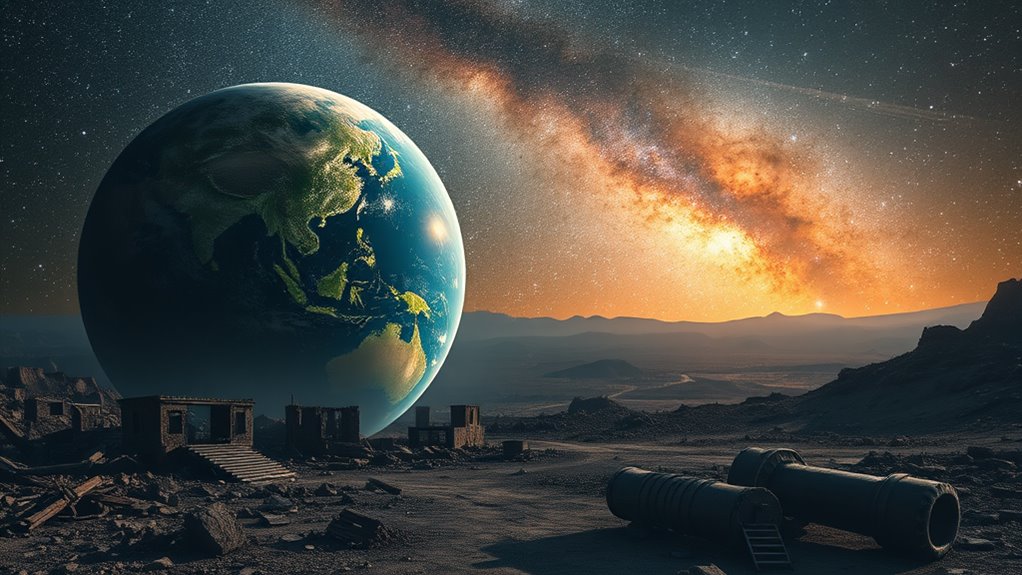
As we ponder the future of our own civilization, it's essential to reflect on the implications for extraterrestrial life. The challenges we face with climate change and technological advancement aren't unique to us; they likely apply to other extraterrestrial civilizations as well.
The concept of universal sustainability suggests that if advanced civilizations can't harmonize with their environment, they may face self-destruction within a thousand years. This raises questions about how many civilizations have experienced this cycle of growth and collapse.
The Great Filter hypothesis provides a potential explanation for the absence of detectable extraterrestrial life. If self-destruction acts as a barrier, it might explain why intelligent life is so rare in the universe. It's sobering to think that the very technologies we develop could lead to our downfall—whether through resource depletion, ecological collapse, or even war.
Given this short survival window, the search for technosignatures becomes more complex. Astrobiologists must grapple with the possibility that civilizations self-destruct before they can communicate or spread across the cosmos.
The implications are profound: if we can't achieve sustainable practices, we risk becoming just another example of a failed civilization. Ultimately, the fate of humanity may serve as a cautionary tale for extraterrestrial civilizations.
If we want to avoid our own extinction, we need to understand and address these universal challenges. Our future isn't just about us; it's about the potential futures of life beyond Earth.
The Path Forward for Humanity

The future of humanity hinges on our ability to come together and tackle the pressing challenges we face. By embracing collective action, we can address the myriad risks threatening our survival, from climate change and technological hazards to resource depletion and global conflicts.
It's clear that the path forward requires a united front, where individuals and communities work together for a common cause.
To build a resilient future, consider these key aspects:
- Cross-cultural collaboration: Engage with diverse groups to advocate for peace and justice, emphasizing our shared humanity.
- Equitable resources: Aim for access to essential services, like healthcare and education, ensuring that all voices are heard and supported.
- Education and awareness: Commit to spreading knowledge about critical issues, inspiring others to join movements for change.
- Non-violent approaches: Promote solutions that avoid harm, focusing on dialogue and understanding rather than conflict.
We must also focus on developing essential survival skills, enhancing not just our individual resilience but that of our communities.
By fostering self-reliance and situational awareness, we prepare ourselves for any future emergencies.
The time to act is now. We can't depend solely on leaders or politicians; it's up to us, the people, to drive change.
Together, by pooling our resources and knowledge, we can navigate the complexities of our world and secure a brighter future for generations to come.
Frequently Asked Questions
What Role Do Technological Advancements Play in Preventing Extinction?
Technological advancements play a vital role in preventing extinction by enhancing our resilience to climate change and environmental threats.
You can leverage AI ethics to develop responsible AI systems that promote sustainability.
Renewable energy solutions help reduce carbon footprints, while genetic engineering allows for the creation of resilient crops that withstand harsh conditions.
Can Adaptation Strategies Be Developed for Extreme Heat Survival?
Imagine a city transformed into a cool oasis amid a scorching desert. You can develop heat resilience by implementing survival tactics like early warning systems and community cooling centers.
Educating yourself and others about heat-related illnesses will empower you to act during heat waves. By fostering community support and integrating urban planning that prioritizes green spaces, you'll create an environment where everyone can thrive, even when the sun blazes relentlessly overhead.
How Does Extinction Impact Biodiversity Beyond Mammals?
Extinction impacts biodiversity far beyond mammals by disrupting species interdependence within ecosystems.
When one species disappears, it can lead to a domino effect, affecting food chains and habitat stability. This loss compromises ecosystem resilience, making habitats less able to recover from disturbances.
You'll notice that diminished biodiversity weakens ecosystems, resulting in reduced services like pollination and water purification, ultimately threatening the survival of other species and altering the balance of nature.
What Are Potential Psychological Effects of Impending Extinction on Humanity?
Facing the prospect of impending extinction, you might experience existential anxiety, a feeling that challenges your sense of purpose and future.
This anxiety can lead to a collective trauma, affecting how you connect with others and process shared fears.
You may find it difficult to focus on daily life, as thoughts of survival and loss overshadow your experiences.
Ultimately, these psychological effects can reshape societal norms and individual behaviors as you navigate this uncertainty.
How Might Future Societies Prioritize Resources During Extreme Conditions?
In extreme conditions, you'd prioritize resource allocation by evaluating immediate needs and potential impacts.
Survival strategies will focus on high-impact risks, ensuring essential resources are directed toward vital projects.
You'd monitor risk levels and adapt your approach as situations change, addressing manageable risks later.
Utilizing technology for real-time data can enhance your decision-making, ensuring effective communication and planning.
